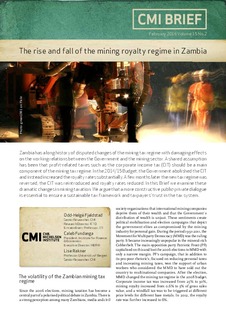| dc.contributor.author | Fjeldstad, Odd-Helge | |
| dc.contributor.author | Fundanga, Caleb | |
| dc.contributor.author | Rakner, Lise | |
| dc.date.accessioned | 2018-01-04T08:20:34Z | |
| dc.date.available | 2018-01-04T08:20:34Z | |
| dc.date.issued | 2016-01-01 | |
| dc.identifier | oai:www.cmi.no:5730 | |
| dc.identifier.citation | Bergen: Chr. Michelsen Institute (CMI Brief vol. 15 no.2) 4 p. | |
| dc.identifier.issn | 0809-6732 | |
| dc.identifier.uri | http://hdl.handle.net/11250/2475120 | |
| dc.description.abstract | Zambia has a long history of disputed changes of the mining tax regime with damaging effects on the working relations between the Government and the mining sector. A shared assumption has been that profit-related taxes such as the corporate income tax (CIT) should be a main component of the mining tax regime. In the 2014/15 Budget, the Government abolished the CIT and instead increased the royalty rates substantially. A few months later the new tax regime was reversed, the CIT was reintroduced and royalty rates reduced. In this Brief we examine these dramatic changes in mining taxation. We argue that a more constructive public-private dialogue is essential to ensure a sustainable tax framework and taxpayers’ trust in the tax system. | |
| dc.language.iso | eng | |
| dc.publisher | Chr. Michelsen Institute | |
| dc.relation | CMI Brief | |
| dc.relation | 2 | |
| dc.relation.ispartof | CMI Brief | |
| dc.relation.ispartofseries | CMI Brief vol. 15 no. 2 | |
| dc.relation.uri | https://www.cmi.no/publications/5730-the-rise-and-fall-of-the-mining-royalty-regime-in | |
| dc.subject | Mining | |
| dc.subject | Taxation | |
| dc.subject | Royalty | |
| dc.subject | Zambia | |
| dc.title | The rise and fall of the mining royalty regime in Zambia | |
| dc.type | Report | |
